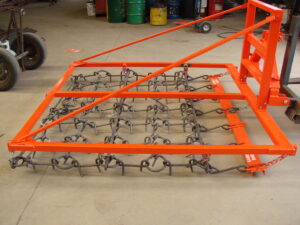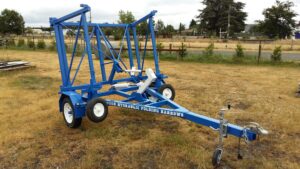How do I promote pasture growth for a dairy farm as cheaply as possible, and how do I minimise dairy farm costs in other ways?
The greatest challenge and issue for dairy farmers, dairy farm managers and dairy farm advisors is how to keep the farm profitable with lower payouts, and ever increasing costs.
In New Zealand the Lyndon harrow has been used for generations in Taranaki and Canterbury to rejuvenate pastures through mild aeration and spreading manure. (that’s free fertilizer and increased palatable grazing when next feeding on that same block of land). All it takes is the purchase of a spike harrow and your away laughing as you already have a work ute or tractor and the employees to complete the quick job of harrowing the paddocks after grazing.
I talked to my brother recently who went to Lincoln University to get his Dip Ag, the thing he cannot understand is why more people do not use their existing labour on the farm to do more maintenance and improvement work. “What do these staff actually do during the day if they are only shifting the herd from paddock to shed?” he asked me. “I remember doing plenty of repairs, maintenance and pasture management on all the dairy farms I worked on throughout Canterbury”
My brother now lives in NSW working for one of the big banks but he and I did grow up on dairy farms in, Waikiti Valley, BOP and Canterbury throughout the 70’s and 80’s…..it was all border dykes in Canterbury back then…..some of you will remember those days.
The only answer I had for him was that the local labour force has become much smaller (and in many cases hired from non-farming based countries), and that we are possibly missing an opportunity over the next 15-20 years to pay ‘a bit more’ money to get skilled people into the dairy industry that are looking for change. Think about this, if you were to pay $60,000 versus $40,000 what could you get for that extra $20,000 with a practically skilled person on a dairy farm? Perhaps you could hire someone with a fencing, building, irrigation, fabrication background…the list goes on and they are out there.
You can quickly train these practical people to look after the dairy farm stock movements and basic dairy shed upkeep that your lower paid employee currently does. Then; consider what the employee is capable of that you are paying the extra $20,000 to employ….if they come from any sort of trade background, or rural upbringing and are over 40 years old, then odds are you have got a very diverse set of skills at your disposal. I am not talking about tertiary educated knowledge such as animal, pasture and financial management skills, these are very important of course and are certainly required to run a complex business such as your dairy farm.
Right, now take out the cost of having to outsource many of your practical jobs on the farm by having these practically skilled employees capable of undertaking many of these improvement and repair tasks…or at least a good portion of them. If you are based ‘off farm’ then you may currently only get a quarterly report from your farm manager on the ‘forecast expenditure for capital projects and the upcoming repair programme’.Along with this report will be the quotes to do that work, but how great would it be to have control over that work by having this person already employed on your farm that could undertake the improvement work? Not only would you save real $$ by not outsourcing the work at market trade rates, but you get the employee engagement benefits by them undertaking the task at hand (that’s ownership) along with the satisfaction of the employee seeing the improvement working for them on a daily basis to make their job easier. This employee engagement in turn leads to discretionary effort. Discretionary effort from engaged employees is the basis of all top performing companies around the world. (Certainly it has been for the large companies I have worked for, which included American company Fedex Express, and trust me they are no slouch when it comes to producing high performing people which lead to strong financial success!!)
OK that all sounds worthwhile considering you are thinking, but where do I find people with skills like this to assist with my dairy farm performance and profitability?….they are actually everywhere and looking at their options now…but every year that goes by there are less of them prepared to change careers…tick tock.
‘Sunsetters’ is an endearing term sometimes used to describe these people. They are all generally over 50 years old, they are often being marginilsed at work as a younger generation pushes them aside with better IT skills. You do not need to look far in a dairy shed to see the same thing rapidly happening with technology…all very cool tools to have of course but that is not what we are talking about here. These sunsetters are hungry for being paid well to work in an environment that is autonomous, good for their health, hard work is no problem and they like to see ‘real world’ tangible outcomes from their efforts (not screen shots or KPI stats)……that is easy to achieve working on a dairy farm.
The time is now to pitch your hiring at these sunsetters , they are comfortable enough in their jobs, but not happy with the prospect of spending the next 15 – 20 years being threatened with getting ‘pushed’ out of their jobs by the new youth coming through. These people learnt skills from their fathers and mothers that are not generally taught to children in the current environment….. using tools, fixing a fence with hammer & nails, planting trees, changing a tyre, changing a tap washer…. Don’t get me wrong, I am steering my kids to get into computer science, architecture, engineering or the health sector but that is pretty normal for parents these days….trying to guess what is best for the next generation of employees….
The point being that a small portion of kids seem to be attracted to dairy farming, or any farming for that matter, we all hope that the great work the industry is doing now to promote dairy farming as a career will pay dividends but for now we require a solution. I have worked with several +65 year old employees in recent years, they are not keeling over at that age and in fact are often fitter and more willing than most of the 25 year olds….better eating habits and a lot less sugar (think about all those energy drinks and other processed rubbish that is currently being consumed). If you target these sunsetter employees and hire them at 50 or 55, you can expect to have a good 15-20 years solid employment from them. That has got to be better than most peoples expectations of how long a younger employee will stay with you these days……its got to be worth a crack….don’t worry about the extra wages you may have to pay initially…employees at that age have gone through their high expenditure period of life already, they will not be constantly at you for wage rises as their cost of living is most often decreasing as opposed to increasing. See how you go!
Anyway, getting back to harrowing….like all good things harrowing eaten pastures require a bit of effort, but why would we have so many customers harrowing dairy pastures post-feed if it did not provide solid results? It does not appear you will hear a farm advisor recommending harrowing, at least none I have heard of anyway…..they are advising based on a raft of different calculations learnt through varsity so I can understand they do not want to promote what they have not been taught. All we can do at Lydnon Harrows is share the knowledge about harrowing benefits and people can make their own decision on what options are best going forward.
Is this info just about selling harrows…well sure we would like to see more Lyndon Harrows out there, but if a dairy farmer buys from a competitor then that is still good for us as its another dairy farm improving their pastures for a very low ‘whole of life’ cost, and when they share that experience we may see our harrow solution into the next farm….in addition if a farm can save cost and improve pastures then they can use that money to spend elsewhere in the rural economy.
Thanks for reading the blog (or is it a post?)……we will continue sharing with you what we see working around NZ farms.
Catch you next time.
EH.
See below for some harrow info
Video of use on a farm. (after some regrowth)
Above – the basic Lyndon spike frame harrow hitched to 3PL.
Below.
Hydraulic folding frame trailer unit (4 mtr version). This can be towed on the open road between paddocks and zips along easily out on the pasture with either truck or tractor. (manual hydraulic pump or direct feed hydraulic are fitted)
Catch you next time.
EH.
.



